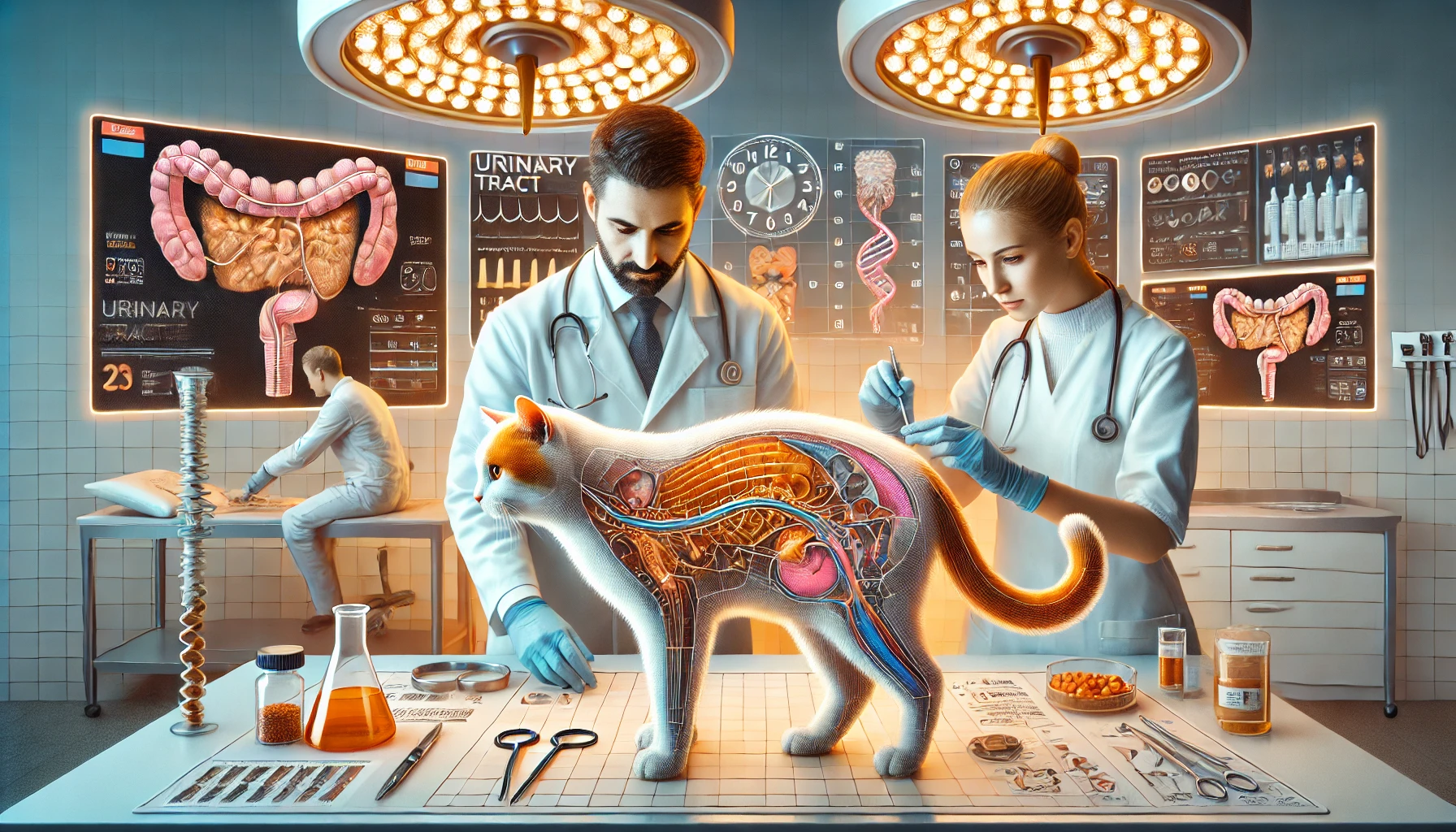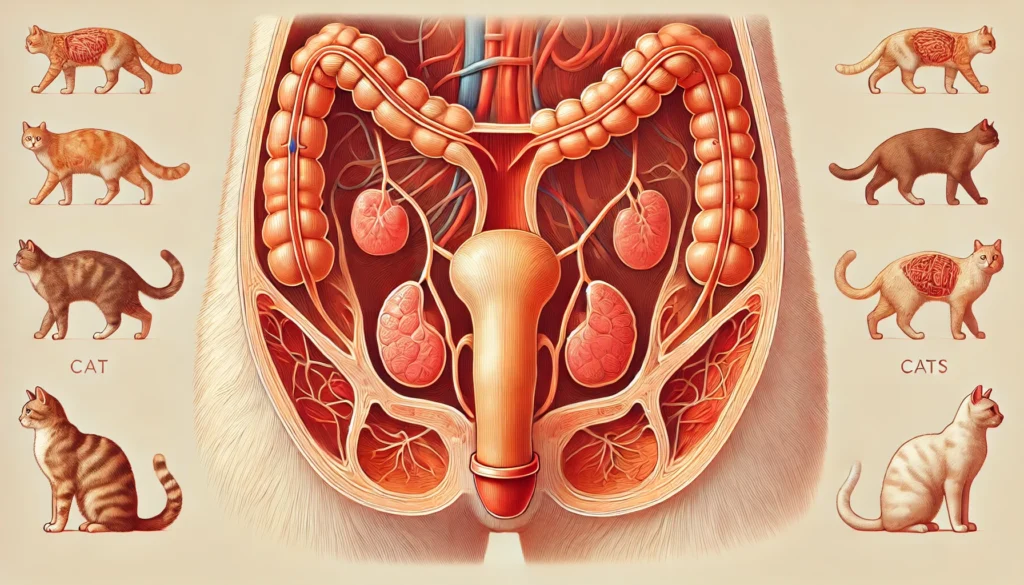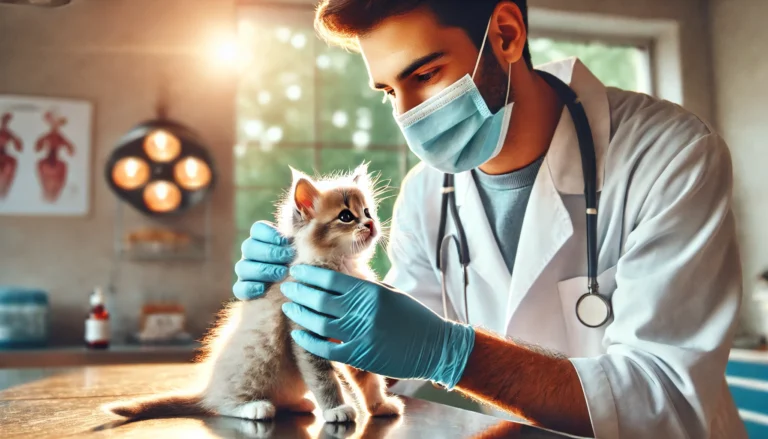Urinary Tract Blockage in Cats

are you looking for Urinary Tract Blockage in Cats?
YES!Urinary tract blockage in cats is a serious medical emergency for cats that can be fatal within days. If you suspect your cat has a blockage, you should contact your veterinarian immediately.
Urinary tract blockage in cats, such as the inability to pee or straining to urinate, are severe health concerns in cats, particularly in male cats. Known medically as feline urinary obstruction, this condition necessitates immediate veterinary attention to prevent complications and ensure the health and well-being of your cat.
Causes of urinary tract blockage in cats
Dietary Factors
Factors such as diet can influence the formation of urinary crystals, leading to blockages. Feeding practices that reduce the risk of crystal formation include ensuring a balanced intake of minerals and providing a moisture-rich diet to prevent dehydration.
Genetic Predisposition
Certain breeds have a genetic predisposition to urinary health issues. Regular health checks can help catch symptoms early, potentially avoiding severe blockages.
Physical and Environmental Factors
Obesity and low water intake can exacerbate the risk of developing urinary blockages. Ensuring your cat maintains a healthy weight and has access to clean water at all times is crucial.

Recognizing the Signs and Symptoms
Straining to Urinate
One of the primary signs of a urinary tract blockage in cats is a cat straining to pee but producing little to no urine. This condition can be painful and is often accompanied by the cat frequently licking its genital area due to discomfort.
Other Symptoms
- Frequent Attempts to Urinate: Cats with a blockage may frequently enter their litter box.
- Painful Urination: Cats may cry out or howl due to pain.
- Vomiting and Lethargy: These symptoms can indicate the severity of the blockage.
Diagnosing urinary tract blockage in cats
Diagnosing urinary tract blockage in cats requires a thorough evaluation by a veterinarian, as this condition can be life-threatening if not treated promptly. The diagnosis typically involves a combination of physical examination, diagnostic tests, and imaging techniques. Here’s how veterinarians generally go about diagnosing urinary tract blockage in cats:
1. Physical Examination
- Palpation of the Abdomen: The vet will gently palpate (feel) the cat’s abdomen to check for signs of a distended bladder. A full, firm bladder may indicate a blockage.
- Behavioral Signs: The vet will ask about any observed symptoms such as frequent trips to the litter box, straining to urinate, or signs of discomfort when urinating. They’ll also assess for signs of pain, lethargy, or distress.
- Dehydration and Shock: A blocked urinary tract can lead to dehydration, so the vet will check for signs like dry gums, sunken eyes, or poor skin elasticity. Severe cases can also lead to shock.
2. Urine Analysis (Urinalysis)
- Visual Inspection: The vet may collect a urine sample to examine its appearance. Blood in the urine (hematuria), crystals, or an unusual odor can suggest infection or inflammation.
- Microscopic Examination: The vet will look at the urine under a microscope to check for abnormal cells, bacteria, crystals, or other signs of infection or inflammation. This can help rule out infections as the cause of the blockage.
- Urine pH and Specific Gravity: The pH of the urine and its specific gravity (concentration) can offer clues about the type of blockage or underlying issue. For example, high pH levels can indicate a predisposition to urinary crystals.
3. Blood Tests
- Complete Blood Count (CBC) and Chemistry Panel: These tests help assess the overall health of the cat and check for complications like kidney damage, infection, or electrolyte imbalances (which can result from a blockage). Elevated levels of certain markers, like creatinine or BUN (blood urea nitrogen), may indicate kidney dysfunction due to the blockage.
- Electrolyte Imbalance: A blocked cat can experience high potassium levels (hyperkalemia), which can cause severe complications, including heart arrhythmias. Blood tests help determine electrolyte balance.
4. Imaging Techniques
- X-rays: X-rays can help the veterinarian detect bladder stones, a full bladder, or any structural abnormalities in the urinary tract. They may also show the size and shape of the bladder and potential obstructions.
- Ultrasound: An ultrasound provides a more detailed view of the urinary tract, helping to identify any blockages, inflammation, or abnormalities in the bladder or urethra. It can also provide insight into whether the kidneys are affected.
5. Catheterization or Cystocentesis
- Urethral Catheterization: If the vet suspects a blockage and confirms a distended bladder, they may attempt to relieve the blockage by inserting a urinary tract blockage in cats catheter through the urethra to allow urine to flow freely. This also helps determine the exact location of the blockage (whether it’s in the urethra, bladder, or elsewhere).
- Cystocentesis (Bladder Tap): In cases where catheterization isn’t possible or the vet needs to confirm a diagnosis, a needle may be inserted directly into the bladder to extract urine for testing.
6. Additional Diagnostic Tests (if needed)
- Culture and Sensitivity Testing: If there is an infection or the vet suspects bacterial involvement, a urine culture may be performed to identify the specific bacteria causing the issue and determine which antibiotics would be most effective.
- Urinary Tract Imaging (CT or MRI): In rare cases, more advanced imaging like a CT scan or MRI might be used to identify any underlying abnormalities, such as tumors, structural defects, or recurrent blockages.
7. Differential Diagnosis
The vet may also rule out other potential causes for the symptoms, such as:
- Feline Idiopathic Cystitis (FIC): A painful inflammation of the bladder that can mimic the signs of a urinary blockage.
- Urinary Tract Infections (UTIs): Often, UTIs and blockages occur simultaneously, so a full evaluation is necessary.
- Bladder Stones or Crystals: Crystals or stones in the bladder or urethra can cause obstruction. The vet may perform imaging to confirm this.
do you know
Arthritis in cats, often overlooked, is a common ailment that can significantly impact the quality of life of our feline friends, especially as they age. This detailed exploration of feline arthritis will cover the nature of the disease, symptoms, diagnosis, treatment options, and practical ways to improve life for a cat with arthritis.
Recovery and Management
Recovery and management of urinary tract blockage in cats is critical for both immediate relief and long-term health. Once the blockage has been cleared and the cat has been stabilized, the recovery process involves a combination of medical treatment, ongoing monitoring, and preventive care to ensure the condition does not recur.
1. Immediate Post-Blockage Treatment
After the blockage is cleared (usually through catheterization or surgery), the focus is on stabilizing the cat and preventing further complications:
- Intravenous (IV) Fluids: IV fluids are commonly administered to rehydrate the cat, restore electrolyte balance, and flush out toxins that may have built up due to the blockage.
- Pain Management: Cats that have experienced a urinary blockage are likely to be in pain. Pain relief medications, such as NSAIDs or opioids, may be prescribed to manage discomfort during recovery.
- Monitoring for Complications: The vet will closely monitor the cat for signs of complications, such as:
- Recurrent blockages: Some cats may experience reobstruction after the initial blockage is cleared, which requires additional treatment or catheterization.
- Electrolyte imbalances: Abnormal potassium and other electrolytes levels can lead to heart arrhythmias or kidney issues.
- Kidney function: Blood tests will be used to check the cat’s kidney function, as prolonged blockage can result in kidney damage.
2. Managing the Cat After Discharge
Once your cat is stable and ready to go home, there are several key management steps to ensure full recovery:
- Post-Operative Care: If surgery was required, follow your vet’s instructions carefully. This may include restricting activity, administering pain medications, and monitoring for signs of infection or complications at the surgical site.
- Urinary Catheter Care (if applicable): If a catheter was placed, you may need to care for it at home under the vet’s guidance. This might involve monitoring for signs of infection, keeping the catheter clean, and ensuring proper urine flow.
- Medications: Your vet may prescribe antibiotics if there was a bacterial infection, or medications to help manage inflammation, pain, or bladder spasms. Make sure to follow the prescribed medication schedule.
- Diet and Hydration: Ensure your cat has constant access to fresh water. Dehydration is a common issue in cats with urinary problems, so encouraging water intake is essential. You may be advised to switch to a special diet designed to dissolve crystals or prevent stone formation. Canned food, which has a higher moisture content, can also help keep your cat hydrated.
3. Monitoring and Follow-up Care
- Frequent Vet Visits: Follow-up visits are crucial to monitor your cat’s recovery. These appointments allow the vet to check for any signs of recurrent blockages, urinary tract infections, or kidney issues. Regular urine tests, blood work, and imaging (like ultrasound or X-rays) may be recommended.
- Urinary Output Monitoring: Keep track of your cat’s urinary habits at home. Make note of whether they are urinating regularly and if they show signs of straining or discomfort. Any changes in their urination patterns should be reported to your vet.
4. Preventing Future Blockages
Preventing future urinary tract blockages involves addressing the underlying causes of the obstruction and making lifestyle changes to help support urinary health:
- Dietary Management:
- Prescription Diet: If your cat has been diagnosed with bladder stones, urinary crystals, or a predisposition to blockage, your vet may recommend a prescription diet specifically designed to dissolve crystals or prevent stone formation.
- Increase Water Intake: Encourage your cat to drink more water. Adding wet food to their diet is an effective way to increase their fluid intake. You could also use a pet water fountain to entice them to drink more regularly.
- Monitor Weight: Overweight cats are at higher risk for urinary issues. Keeping your cat at a healthy weight through portion-controlled feeding and regular play can help reduce the risk of blockages.
- Litter Box Management:
- Keep the Litter Box Clean: A dirty litter box can discourage your cat from urinating regularly. Clean the litter box frequently to ensure your cat has a clean, comfortable place to go.
- Number of Litter Boxes: Provide more than one litter box if you have multiple cats, to reduce stress and territorial marking that might contribute to urinary issues.
- Stress Reduction:
- Reduce Stress: Cats are highly sensitive to stress, and stress can contribute to conditions like feline idiopathic cystitis (FIC), which is sometimes seen alongside urinary blockages. Create a calm environment by minimizing changes in the household, providing vertical spaces for climbing, and using feline pheromone diffusers (such as Feliway) to help reduce anxiety.
- Behavioral Enrichment: Engaging your cat with interactive toys, playtime, and opportunities for exploration can help alleviate stress and prevent behavioral issues related to urination.
- Regular Vet Check-ups: Regular veterinary check-ups are essential to monitor your cat’s urinary health. Catching early signs of urinary tract issues, such as straining to urinate or blood in the urine, can help prevent future blockages and ensure prompt treatment.
5. Signs of Recurrence or Complications
Even with proper recovery, some cats may be prone to recurrent blockages or urinary tract issues. Watch for signs that might indicate a return of the problem:
- Straining or difficulty urinating
- Frequent trips to the litter box with little or no output
- Blood in the urine
- Vocalization or signs of pain while urinating
- Licking the genital area excessively
Conclusion
Urinary tract blockage in cats is a serious and potentially life-threatening condition that requires immediate veterinary attention. Whether caused by urethral obstructions, bladder infections, or other underlying health issues, prompt diagnosis and treatment are crucial to prevent long-term damage to the urinary system or even kidney failure. Preventative measures, such as ensuring your cat has access to clean water, a proper diet, and regular veterinary check-ups, can help reduce the risk of urinary tract issues. If you notice symptoms like frequent urination, straining, blood in the urine, or changes in behavior, it’s important to seek veterinary care right away. Early intervention and proper care can significantly improve your cat’s prognosis and quality of life.
What is a Urinary Tract Blockage?
A urinary tract blockage in cats, also known as urethral blockage, occurs when an obstruction prevents urine from exiting the bladder. This blockage can be caused by crystals, mucous, or small stones and is more common in male cats due to their narrower urethras.
How do you unblock a cat’s urinary tract?
To unblock urinary tract blockage in cats, immediate veterinary care is crucial. The vet will likely perform a physical examination and may use diagnostics like X-rays or an ultrasound. Treatment typically involves the insertion of a catheter to relieve the blockage and flush out any obstruction such as crystals or stones.
How long can a cat survive with a urinary blockage?
A urinary blockage in cats is an emergency requiring immediate treatment. Without intervention, cats can experience life-threatening complications within 24 to 48 hours. The buildup of toxins and pressure can lead to kidney failure, bladder rupture, and severe metabolic disturbances, making prompt veterinary care essential to prevent fatal outcomes.
How long can a cat survive with a blockage?
The survival time for a cat with a urinary tract blockage in cats without treatment can be very short, usually 24 to 48 hours, as toxins build up quickly and can lead to kidney failure and potentially fatal complications. Immediate veterinary intervention is crucial to relieve the blockage and prevent severe health consequences.
How can I help my cat clear a blockage?
Home treatment for urinary blockages in cats is not advised; veterinary intervention is necessary. If you suspect a blockage, keep your cat calm and hydrated and take it to a vet immediately.
How do I help my cat who is struggling to pee?
If your cat is struggling to pee, it is essential to consult a veterinarian immediately as it can be a sign of a urinary blockage, which is life-threatening. At home, ensure your cat has continuous access to clean water and a clean litter box. Follow any prescribed diets or medication regimens from your vet strictly.
How to stimulate a cat to pee?
To stimulate a cat to pee, gently massage the bladder area, which can help encourage urination. However, this should only be done under veterinary guidance to avoid any harm if the bladder is full and the cat is unable to urinate due to a blockage. Ensuring your cat has access to fresh water and a clean litter box is also crucial.
How to tell if a cat has blockage?
Signs that a cat may have a urinary tract blockage in cats include inability to urinate, crying or straining in the litter box, licking the genital area excessively, abdominal pain, lethargy, and vomiting. If you notice these symptoms, especially straining without producing urine, it is essential to seek immediate veterinary care.
Can a cat regain bladder control?
Yes, a cat can regain bladder control depending on the cause of the loss. With appropriate medical treatment for conditions like urinary blockages or infections, normal bladder function can often be restored. In cases involving nerve damage, recovery may be partial or require ongoing management, including medications or special care.
How can I strengthen my cat’s bladder?
Strengthening a cat’s bladder can be achieved by ensuring a healthy diet that promotes urinary health, providing plenty of fresh water to encourage regular urination, and maintaining an ideal body weight. Your vet might also recommend specific supplements or foods designed to support bladder health and reduce the risk of urinary issues.
What are the symptoms of kidney failure in cats?
Symptoms of Urinary tract blockage in cats include increased thirst and urination, dehydration, weight loss, lethargy, decreased appetite, vomiting, and a dull coat. As kidney failure progresses, cats may show signs of oral ulcers, bad breath, and anemia. Early detection and veterinary care are crucial to manage this condition effectively.






